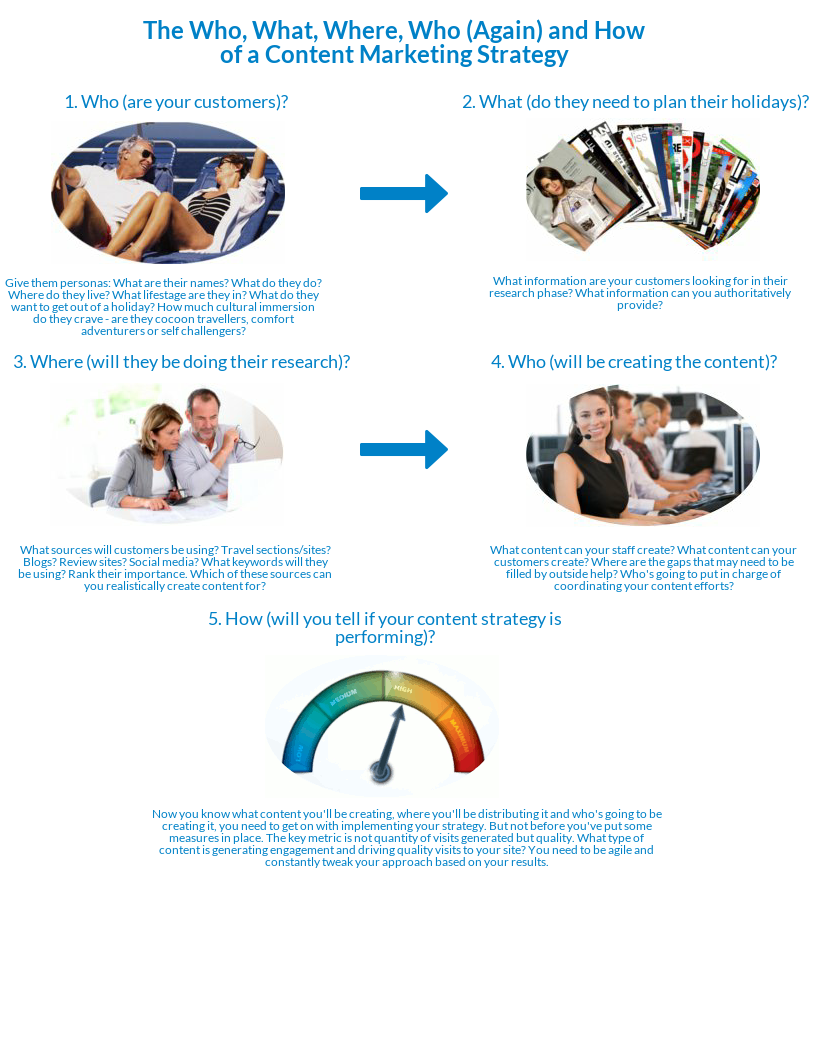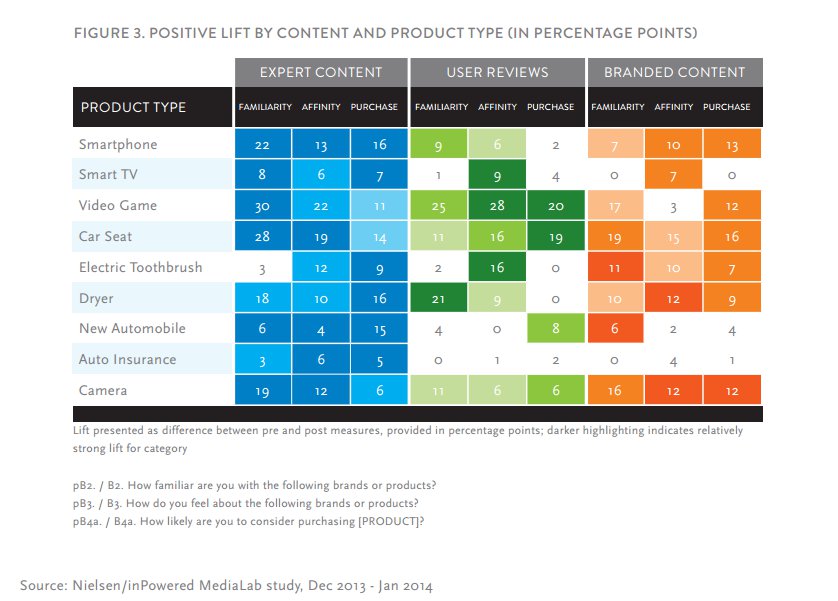Posts
The Who, What, Where, Who (Again) and How of a Content Marketing Strategy
/0 Comments/in Content Generation, Featured /by Ben BlacklerSo you’ve decided to make content part of your marketing efforts. How do you turn that intent into a concrete strategy? Here’s my who (x2), what, where and how of a content marketing strategy.
1. Who (are your customers)?
If you haven’t already, I’d create personas for your major customer types. Give them a names and occupations. Who do they holiday with? What do they want to get out of their holidays (the cultural immersion model might help you here). The more you can flesh the out and make them real people, the easier it this process will be.
2.What (do they need to plan their holiday)?
Don’t forget, the reason you’re investing in a content strategy is to help your potential customers earlier in the purchase cycle. That means your brand is likely to be involved right at the top of the purchase funnel (and therefore more likely to be involved at the bottom too). It also means you’ll build up favours in the customers’ favour bank, which makes a final purchase more likely. What information will be they looking for during that research? What information can you authoratively provide?
3. Where (will they be going to do their research)?
What are the authority sources that those potential customers will consult during their research process? Is it feasible to get your content onto these sources – even if just via comments? Google is going to be the first port of call for many. What keywords will they be using? Your content strategy will involve featuring the main keywords in your content. Don’t forget – the keywords potential customers use at the top of the funnel will be different – more generic – than the ones that drive traffic to your site.
4. Who (will create the content)?
Having decided what content you’re going to create, you need to look at who’s going to create that content. What can you staff create? What can your existing customer’s create? If there are gaps, you might might need to bring in some outside help. The other ‘who’ here is the person you’re going to put in charge of the delivery of your content strategy – the person that’s responsible for it’s delivery, coordinating the various creators and making sure they deliver.
5. How (well is your content strategy performing)?
You’ve decided what content you’ll be creating, where you’re going to be distributing it, who’s going to be creating it and who’s going to be coordinating it. Now, you need to get on with it – but not before you’ve set some measures in place. Which pieces of content are driving the greatest amount of visitors to your site and what is the quality of those visits (are they ‘bouncing’ after reading the content or going on to explore your site in more detail)? The content that is driving the greatest amount of quality traffic is the type to focus on. Be agile and constantly adjust your strategy based on your metrics.
Of course, the alternative is to jump straight in and, metaphorically speaking, just through content ‘at the wall’ and see what sticks – but you’ll waste a lot of time and effort (and potentially money) that way so it’s best to take a structured approach. You’ll reach the optimum solution much faster.
Content Marketing – It’s All the Rage But How Well Does It Work?
/0 Comments/in Content Generation, Featured /by Ben BlacklerContent is quite the thing in marketing at the moment. If you’re reading this, you’ve probably already invested in it or are thinking about investing in it.
If you don’t know the theory behind it, it’s all based on Cialdini’s first law of persuasion – the law of reciprocation (or the law of ‘if you scratch my back, I’ll probably be prepared to scratch yours’). If you help someone with useful content, they’ll feel the need to do you a favour back, and that favour will hopefully be some business in the future.
So that’s the theory but does it actually work in practice? Yes, according to a new study produced by inPowered in association with Neilsen.
They took a sample of 900 Americans, recruited off the casino floors of Las Vegas (which seems like an odd recruitment method until your realise that it’s a great way to source respondents originating from all corners of the US) and gave them online questionnaires to complete both before and after being exposed to content related to different product categories. The content the respondents were exposed to was of 3 different types – 3rd party expert, user reviews and branded. The online surveys measured changes in attitudes in 3 different segments of the purchase journey – awareness, affinity and purchase intent.
Here are the results:
To save you examining the chart in detail, here are the main findings:
- Expert content was influential at all stages of the purchase journey for all product categories. It was believed to be more credible than branded content (no surprises there) and more informative then user reviews (well, they are experts after all). Thinking of it from a travel perspective, a write up in a national press travel section is going to carry more weight than copy on a product’s website (be it an hotel, airline etc) or a user review – no surprised there.
- Where product specification was important (in the study, for things like car seats, smartphones or digital cameras), branded content become more influential.
- Where users were deemed to be ‘experts’ then user reviews came into their own. In this study, the prime examples were video games (where gamers trusted other gamers) and car seats (where parents trusted other parents).
- Expert reviews become more influential the more expensive the purchase. User reviews become more influential the lower value the purchase.
- In general, although expert content was the most influential, for most products at most stages of the journey, all 3 types of content had some influence.
Thinking about this study with regard to travel and tourism marketing, the following thoughts occurred to me:
- We all know the value of 3rd party endorsements of our products from the likes of newspapers, magazines, guidebooks, bloggers etc but if we’re not product owners, but rather product recommenders (tour operators, conference & events companies, affiliate sites etc) is our content ‘branded’ or ‘expert’? I’d argue that it’s the latter, so not only can it be highly influential in the purchase journey, we should write that content as if we’re expert reviewers i.e. on the consumers’ side, not on the suppliers side. How often do companies fall into the trap of writing content to appease their suppliers rather than their customers?
- How influential are user reviews? Clearly, the more ‘expert’ those reviewers are, the more influential they are. A Conference or Event Manager would trust the reviews of another Conference or Event Manager. But how influential will someone who’s written a user review on TripAdvisor be? Perhaps the more detailed the review (taking them into the realm of an informative ‘expert’), the more influential it is? Or perhaps it’s the wisdom of the crowd – people look at the aggregate of the feedback and that elevates user reviews on the likes of TripAdvisor onto an ‘expert’ level?
- Product specifications, an area where branded content was seen to be influential, are very important in travel purchase decisions – selecting the best conference room, selecting which airline is best for you, selecting which hotel is best for you, even selecting which destination is best for you relies alot on the ticking of certain boxes.
In general, my impression from this study (other than it’s a pain they didn’t include a travel-related product) is that content is influential, branded content is more influential than perhaps some would expect (50% of the survey didn’t trust branded content to be impartial, but that means 50% did) and the more ‘expert’ (impartial and informative) that branded content can appear, the better.
So if you’ve invested in content, you can breathe a sigh or relief and if you haven’t, what’s stopping you?
Interesting links
Here are some interesting links for you! Enjoy your stay :)Pages
Categories
- Advertising
- Branding
- Content Generation
- Customer Experience
- Direct Marketing
- Featured
- Headline
- HNW Customers
- Marketing Strategy
- Measurement
- Mobile Marketing
- Online Advertising
- Prospect Conversion
- RSS
- Search
- Search Engine Marketing
- Segmentation
- Social Media
- Telemarketing
- Web 2.0
- Websites
- Word of Mouth Marketing


